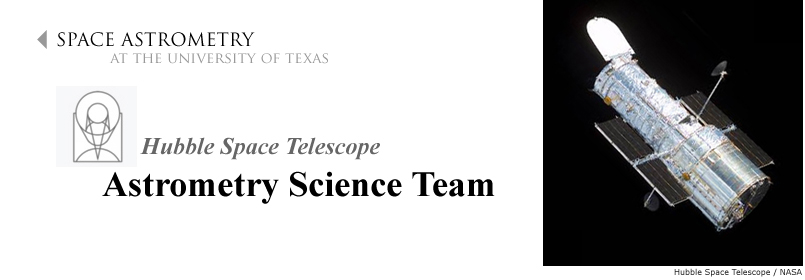
- What we do
We use the Fine Guidance Sensors aboard Hubble Space Telescope to measure star positions and study binary stars unresolvable using ground-based techniques. The Fine Guidance Sensors provide per-observation relative positions with 0.001 arc second angular precision. Stellar positions yield information on distance (parallax) and possible faint companions. The orbits of binary stars yield stellar masses.
top
- Fine Guidance Sensors
If this section merely whets your appetite for FGS information, you will enjoy the HST FGS Instrument Handbook.
Optics
The Fine Guidance Sensors aboard HST are the only readily available white-light interferometers in space. The interfering element is called a Koester's Prism. Each FGS contains two, one each for the x and y axes, as shown in the optical diagram. In 1992 we carried out a series of tests on all three FGS and chose FGS 3 to be the primary astrometer.
Operational Modes
- Fringe Scanning or Transfer Scan Mode (TRANS)
- In this mode, FGS 3 scans over a star image, generating a fringe (a transfer function scan) along each axis. A binary star will generate a linear combination of two transfer response functions. By comparing the TRANS data for a single star with that of a binary, we can determine separation, magnitude difference, and position angle information.
- Fringe Tracking or Position Mode (POS)
- In this mode, FGS 3 locks onto and reports (40 times a second) the position of the null crossing point of the interferometer (the zero-crossing point in the fringe or transfer function).
HST Primary Mirror Misfigure
While the misfigure of the HST primary mirror has not rendered astrometry impossible with HST, it certainly has adversely affected performance. Compare the nearly perfect transfer function along the Y-axis with the corresponding X-axis transfer function. The additional structure seen in the X-axis makes it far more difficult to detect close binary stars. Additionally, slope changes near the null crossing render it a less precise POS mode device.
The New Fine Guidance Sensor (FGS 1r)
During the second HST servcing mission (December 1999) one of the FGS units was replaced with a refurbished and updated ground-test unit. This FGS has an articulated mirror which can minimize the effects of optical misalignments. It produces high-quality fringes on both the X and Y axes. FGS 1r should provide better POS and TRANS astrometry than did FGS 3.
top
- Fringe Scanning or Transfer Scan Mode (TRANS)
- A few representative projects
- A Parallax of the Fundamental Distance Calibrator RR Lyrae
- A Parallax of the TV Columbae
- An Extrasolar Planet Search
- Cleaning Up the Hyades Color-Magnitude Diagram
top
- Projects List
To the left of each project are the proposal numbers assigned by the Space Telescope Science Institute (STScI). These link to detailed information in the STScI Electronic Information System. All data have been collected. We are now processing and analyzing.Parallaxes
[6876] - Parallax of RR Lyrae
[6878] - Parallax of NGC 6853
[6875] - Parallax of delta Cephei
Binary Star Astrometry
[8728] - Companion to W922
[6885] - L726-8/UVCeti
top
- Papers
top
- Software
top
- Who We Are
top
7 October 2005
Astronomy Program · The University of Texas at Austin · Austin, Texas 78712
prospective student inquiries: studentinfo@astro.as.utexas.edu
site comments: www@www.as.utexas.edu
Astronomy Program · The University of Texas at Austin · Austin, Texas 78712
prospective student inquiries: studentinfo@astro.as.utexas.edu
site comments: www@www.as.utexas.edu